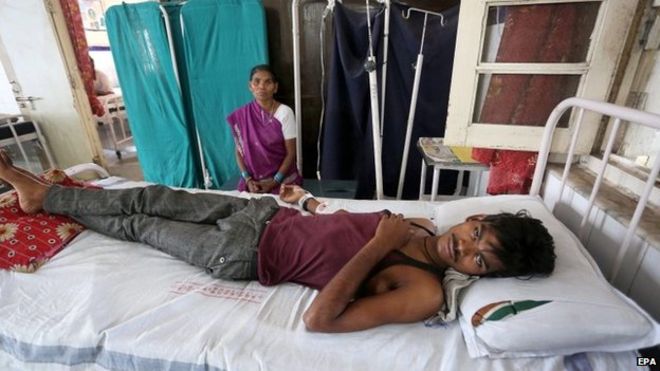The massive heatwave sweeping India is starting to ease, with forecasts of rain in some affected states.
Officials say nearly 1,700 people have died in the worst-hit states of Telangana and Andhra Pradesh, where temperatures rose above 45C (113F).
Clouds have formed over some parts of the two states and weather officials say pre-monsoon showers are likely to provide some relief on Friday.
The monsoon is due to reach Kerala, in the south, by the end of May.
It will then sweep across the country.
In the worst-affected state of Andhra Pradesh, where temperatures have hit 47C (117F), more than 1,300 people are reported to have died since 18 May.
The state’s top meteorological officer YK Reddy told BBC Hindi that heatwave conditions “have reduced considerably” and temperatures have fallen in all but two districts.
In neighbouring Telangana, where officials say at least 340 people have died from heat-related conditions, temperatures have declined.
“For all practical purposes, the heat wave has now ended in our state,” BR Meena, Telangana’s disaster management commissioner, told BBC Hindi.
Meanwhile India’s public hospitals are struggling to cope with patients of the heatwave.
“I have been posted here for seven years, but I am feeling a lot of heat this year. We have been seeing a dozen patients of heat wave every day,” Dr Anjaya of Rajiv Gandhi Institute for Medical Sciences in Andhra Pradesh told the BBC.
Hospitals in the Indian capital Delhi, where temperatures have soared to 45.5C (113.9F) have also seen a large number of patients.
“Hospitals are overflowing with heatstroke victims,” Ajay Lekhi, president of the Delhi Medical Association, told AFP news agency.
“Patients are complaining of severe headache and dizziness. They are also showing symptoms of delirium,” he said.
Reports said there were long queues outside the All India Institute of Medical Sciences, one of Delhi’s largest government-run hospitals.
“Last night there was no electricity for nearly five hours,” Seema Sharma told AFP outside the hospital as she waited in line for her four-year-old son to be examined.
“You can imagine what we must have gone through. He just couldn’t sleep and kept on crying. Now he has fever as well.”
The Delhi-based research organisation Centre for Science and Environment said the high deaths this year could be because of the sudden onset of heat.
“This could be due to the sudden change in temperatures after a prolonged wet February and March that had kept the temperatures cool,” said Arjuna Srinidhi, the group’s programme manager for climate change.
What is a heatwave?
- Heatwaves are defined as periods of abnormally high temperatures and usually occur between March and June in India
- May is the country’s hottest month, with an average maximum temperature of 41C (104F) in Delhi
- Longer, more severe heatwaves are becomingly increasingly frequent globally
- Intense heat can cause cramps, exhaustion and heat stroke
- Thousands of people died across India during heatwaves in 2002 and 2003
- In 2010 around 300 people were killed by intense temperatures, according to media reports from the time
Sources: National Disaster Management Authority of India and BBC









